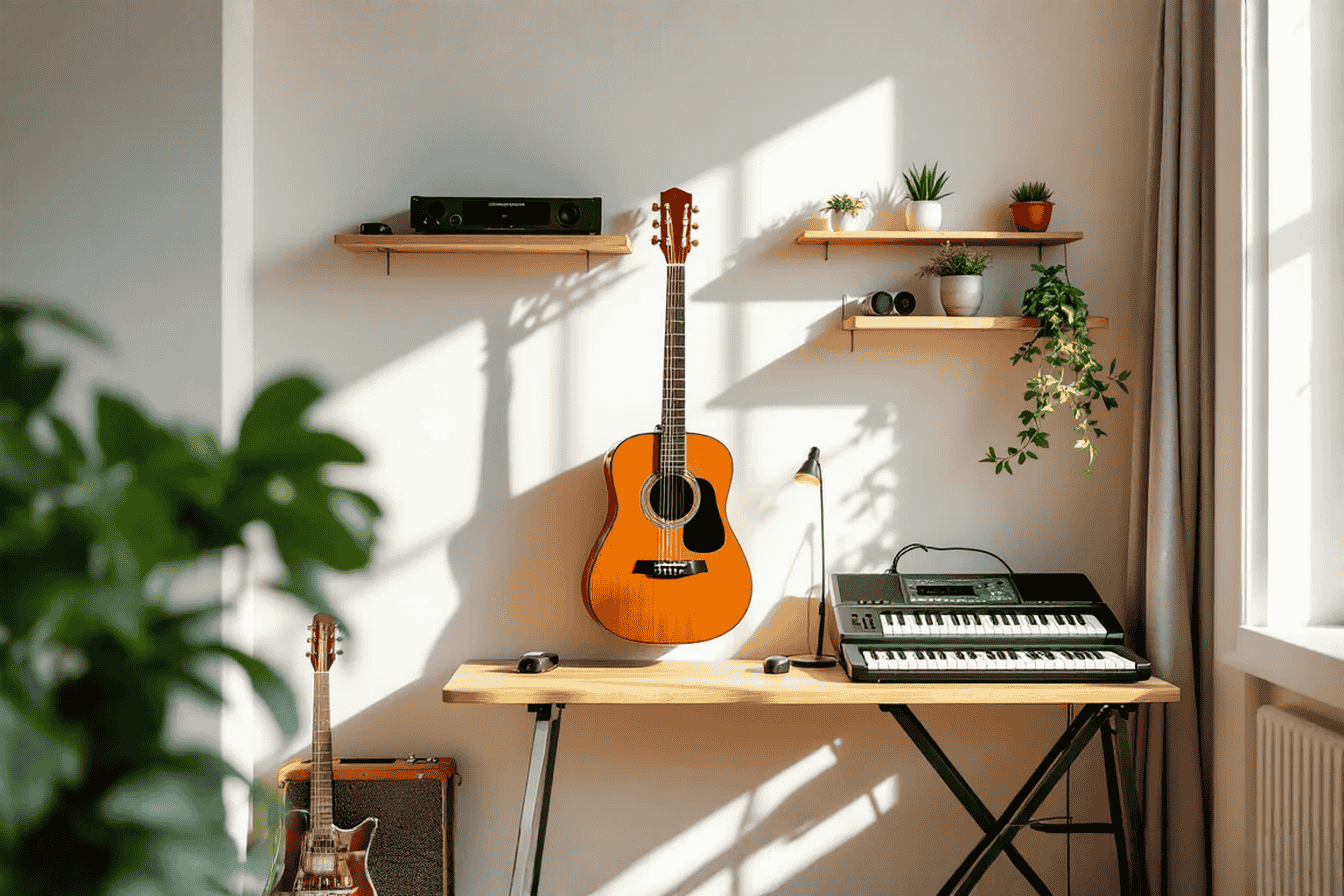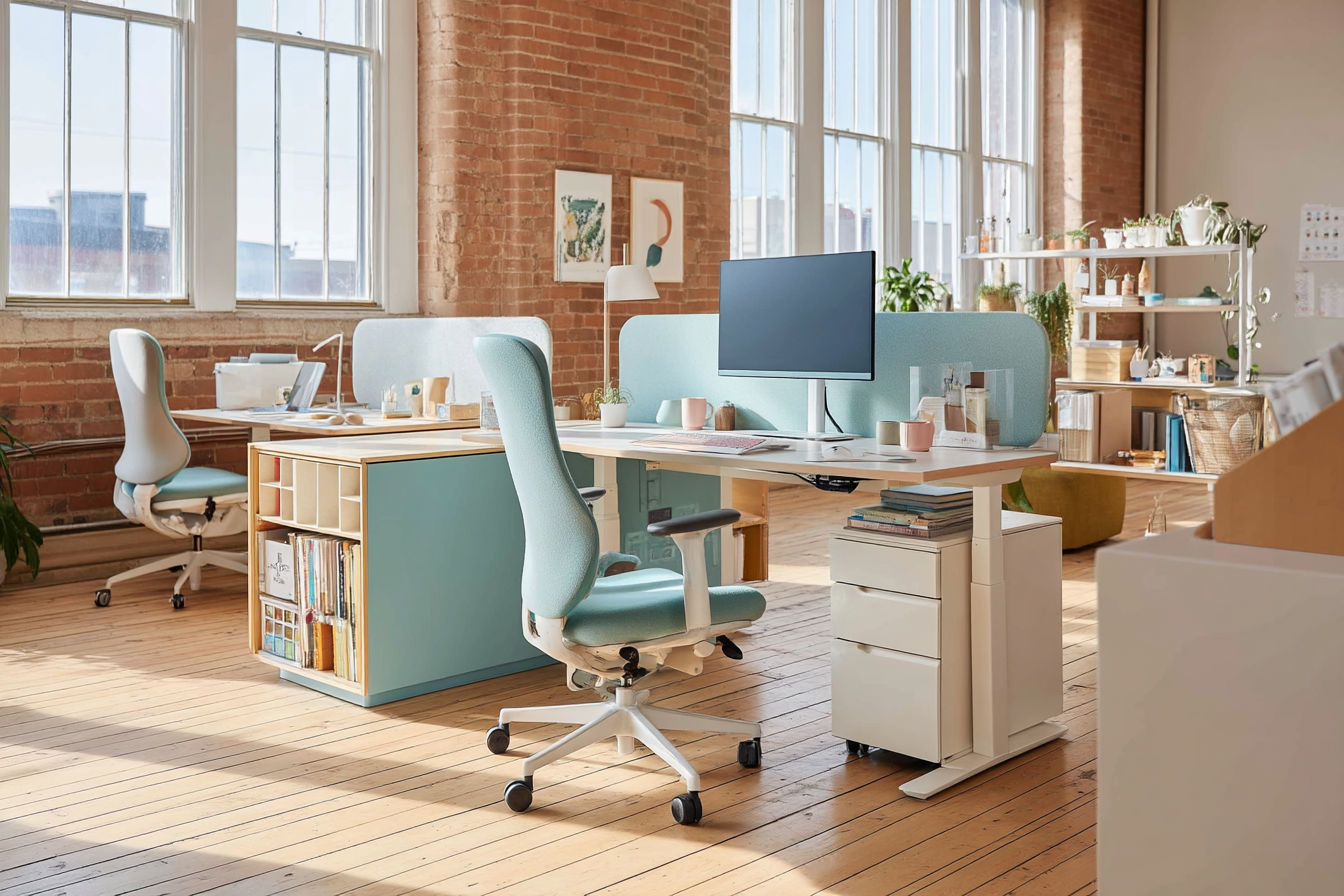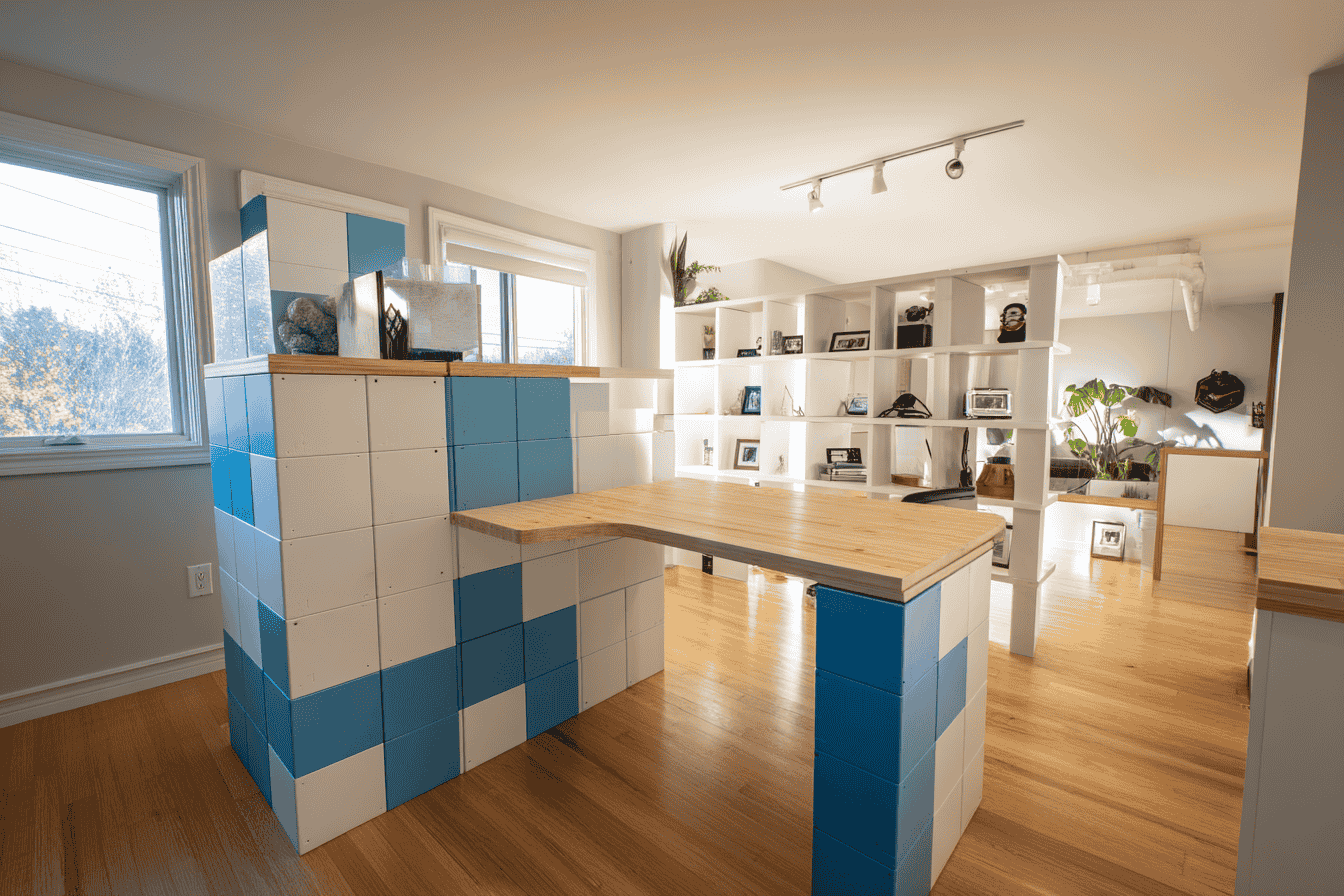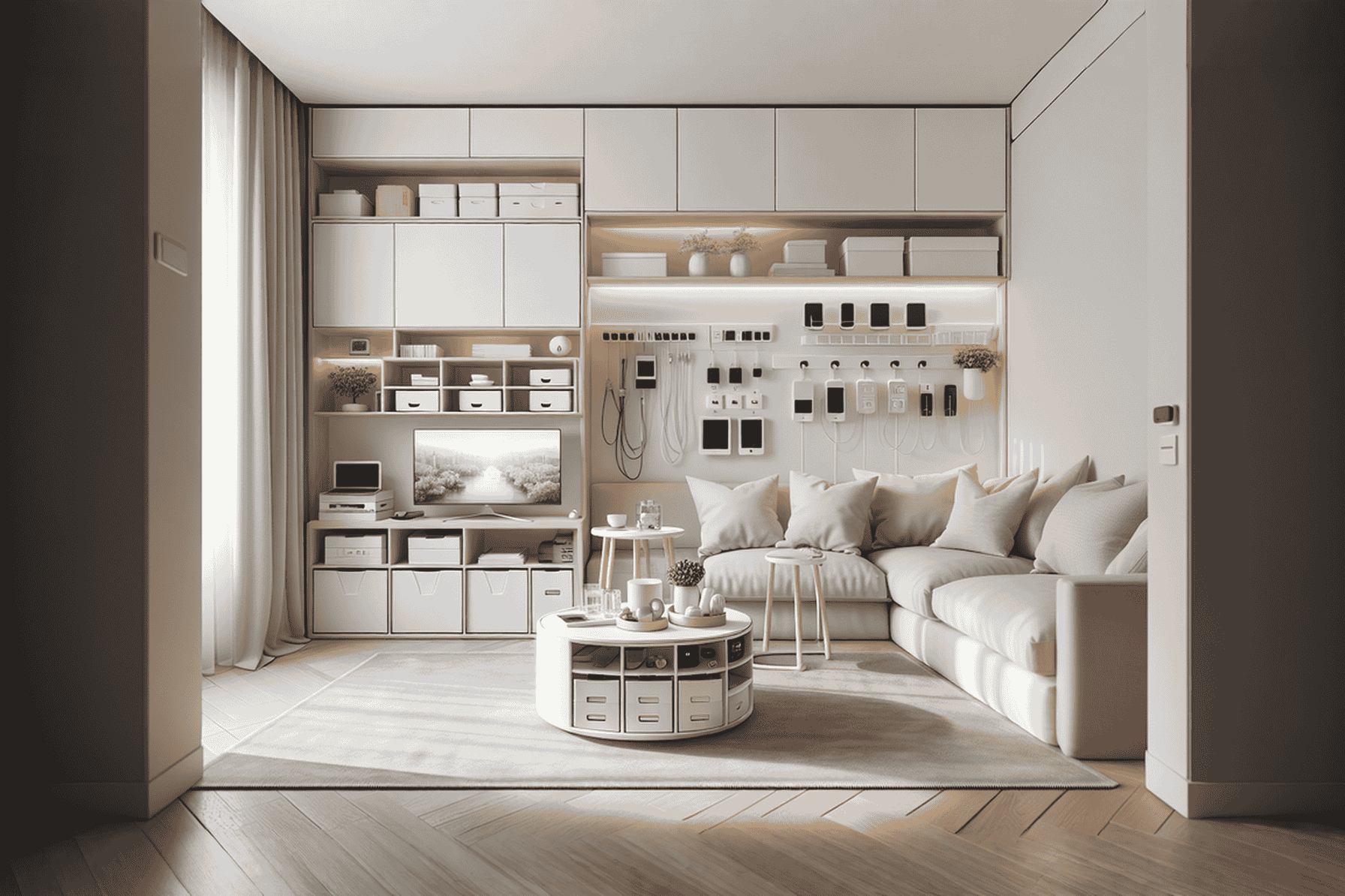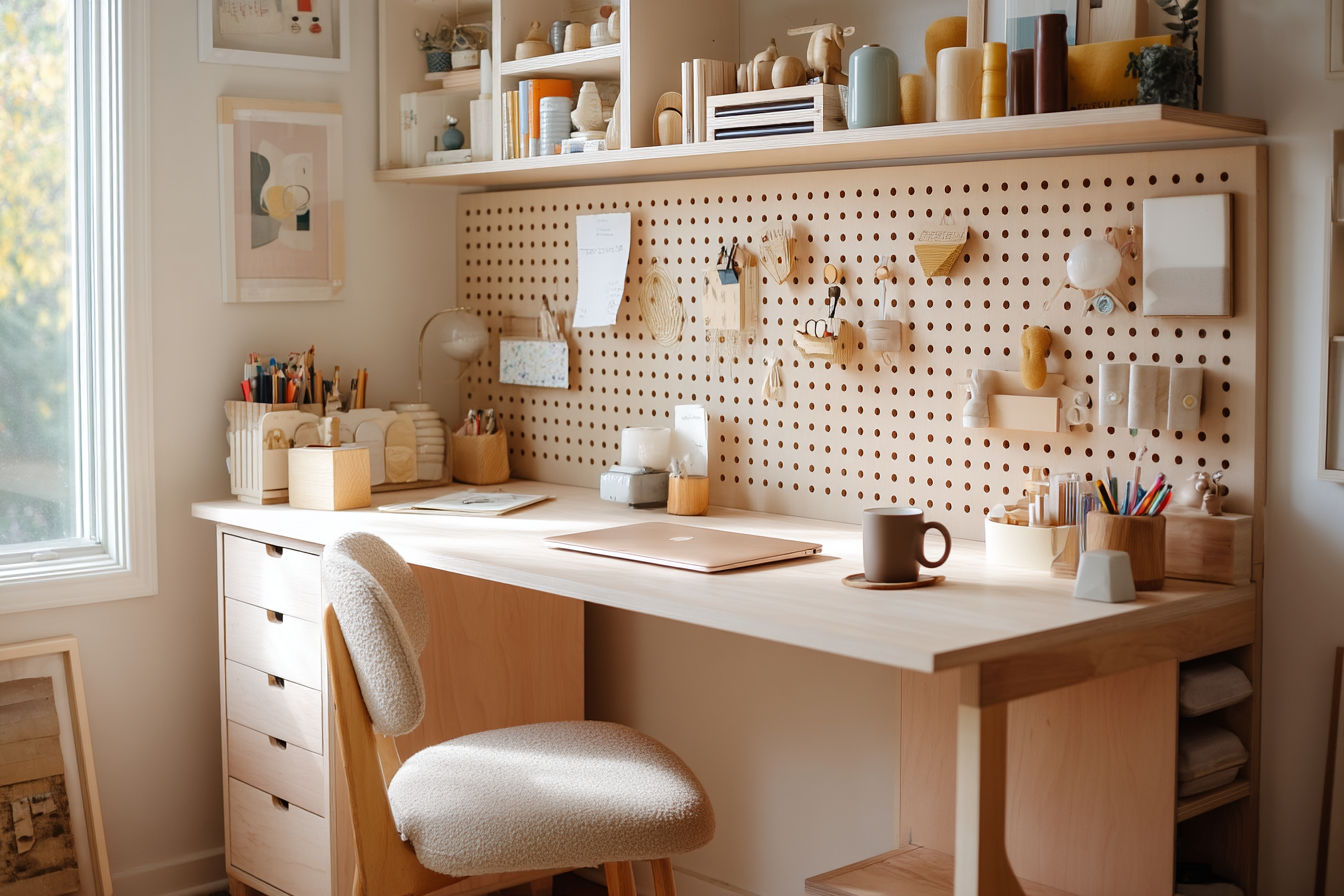This post may contain affiliate links. If you make a purchase through these links, we may earn a commission at no additional cost to you.
The modern workplace has undergone a remarkable transformation over the past decade, shifting from environments designed solely for productivity to spaces engineered for human well-being. This evolution represents a fundamental change in how we view the relationship between work, space, and human health. No longer is it sufficient for workstations to merely accommodate basic functions; today’s office furniture must actively contribute to employee wellness.
Research consistently demonstrates that workplace comfort directly influences not only physical health but also cognitive performance, emotional stability, and overall job satisfaction. The science of workplace comfort now encompasses diverse fields including ergonomics, psychology, environmental science, and even chronobiology—the study of how our bodies respond to light patterns throughout the day.
The Science of Workplace Well-being: Research and Insights
The connection between workplace design and employee wellness is backed by a growing body of scientific research, revealing how our physical environments profoundly impact our health and productivity.
From an ergonomic perspective, workstation design directly affects physical well-being. Studies published in the Ergonomics Journal reveal that employees in properly designed workspaces report up to 35% less musculoskeletal discomfort. This reduction stems from furniture that supports natural body positioning and encourages movement throughout the workday. Dynamic workstations that allow for postural variety significantly reduce the risks associated with sedentary behavior, which has been linked to numerous health concerns including cardiovascular disease, metabolic disorders, and chronic pain.
Mental health considerations have become equally crucial in workspace design. Research published in Workplace Health & Safety demonstrates that proper acoustic design can reduce stress levels by up to 27%. The ability to control one’s sensory environment—managing noise levels, visual distractions, and interpersonal interactions—plays a vital role in maintaining cognitive function and emotional equilibrium during demanding workdays. Privacy options within workspaces help employees manage cognitive load and create boundaries necessary for deep focus work.
Environmental factors form the third pillar of workplace wellness research. Harvard Business Review reports that access to natural light increases workplace satisfaction by 40%, while the Human Spaces Global Report indicates that biophilic elements correlate with 15% higher reported well-being and 6% higher productivity. Perhaps most alarming, research from Environmental Health Perspectives reveals that poor indoor air quality can reduce cognitive function by up to 50%—a stark reminder that invisible environmental factors dramatically impact performance.
These findings collectively point to a clear conclusion: thoughtfully designed workspaces are not luxury items but essential tools for maintaining employee health and organizational performance. The most effective workstation designs incorporate these research insights, creating environments that work with human physiology rather than against it.
Essential Features of Well-being-Focused Modular Workstations
The most effective modular workstations integrate specific features that directly address the physical, mental, and environmental factors crucial to workplace wellness. Understanding these essential elements helps organizations make informed decisions when selecting office furniture systems.
Ergonomic Adjustability and Personalization
Adaptable height settings form the cornerstone of ergonomic workstation design. Sit-stand desks reduce sedentary time by approximately 1.1 hours per 8-hour workday according to the Journal of Occupational Health. This movement capability, combined with properly positioned monitors at eye level and keyboards that maintain neutral wrist positioning, supports proper body alignment throughout the workday. The most advanced systems offer effortless transitions between positions, encouraging users to vary their posture frequently.
Quality workstations also feature ergonomic seating with multiple adjustment points that accommodate various body types and working preferences. Lumbar support, adjustable armrests, and proper seat depth all contribute to reduced physical strain. The ability to personalize these settings empowers employees to create environments that match their unique physiological needs.
Privacy and Acoustic Solutions
Effective modular cubicles incorporate thoughtful acoustic design elements that manage sound transmission without creating isolation. Acoustic panels with varying absorption capacities can reduce ambient noise while maintaining connection to the larger workspace. These features support concentration by minimizing distractions while preventing the psychological stress associated with excessive noise exposure.
Visual privacy elements—including adjustable panels, strategic positioning, and modesty screens—provide psychological comfort by giving users control over their exposure and interactions. The Gensler Workplace Survey indicates that employees with control over their workspace configuration report 32% higher job satisfaction, highlighting the importance of autonomy in workspace design.
Technology Integration and Biophilic Elements
Seamless technology integration eliminates frustration and physical strain associated with cable management and device placement. Sophisticated workstations incorporate power distribution systems, cable management solutions, and dedicated spaces for peripheral devices, creating uncluttered surfaces that support both technological needs and visual calm.
Biophilic elements connect employees with natural patterns and materials, addressing our innate biological need for nature connection even in indoor environments. These features include natural materials like wood surfaces, living plants incorporated into workstation design, nature-inspired patterns, and optimized natural light. These elements reduce stress hormones and increase positive emotional responses to the work environment.
Flexibility and Adaptability
The most successful modular systems offer configuration flexibility that accommodates both current and future needs. Easily reconfigurable components allow workspaces to evolve alongside changing work patterns without requiring complete replacement. This adaptability supports various work styles and activities, from focused individual work to collaborative sessions, enabling employees to modify their environments based on specific tasks and personal preferences.
When these essential features work in concert, they create workstations that actively support well-being rather than merely accommodating basic functions. As we examine specific modular workstation systems in the following sections, we’ll explore how these principles manifest in different design approaches.
Cubicle Well-being: Seven Modular Workstations That Put Comfort First
Modular cubicle workstations have emerged as a sophisticated solution to these multifaceted workplace challenges. Unlike their rigid predecessors, these adaptable systems can be customized to support individual needs while facilitating organizational flexibility. They serve as the intersection between cutting-edge research and practical workspace applications, effectively transforming abstract wellness concepts into tangible office environments that support human thriving.
1: ErgoFlex Adaptive Workspace: Dynamic Comfort for Active Professionals
The ErgoFlex Adaptive Workspace represents a comprehensive approach to dynamic comfort, designed specifically for professionals who understand that movement is essential to workplace wellness. This system empowers users to transition seamlessly between different working positions throughout the day.
At its core, the ErgoFlex features electric height adjustment mechanisms that allow for smooth transitions between sitting and standing positions. Unlike manual systems that may discourage position changes due to their cumbersome operation, the ErgoFlex’s whisper-quiet motors and programmable height presets make postural variety effortless. This functionality directly addresses research showing that regular position changes reduce musculoskeletal strain and increase energy levels.
Air quality—an often overlooked aspect of office wellness—receives dedicated attention through an integrated purification system. This feature continuously filters common office pollutants including VOCs from printers, dust, and airborne particles. The system monitors air quality in real-time, automatically adjusting filtration levels when needed to maintain optimal breathing conditions within the user’s immediate environment.
The ErgoFlex’s customizable privacy screens serve dual purposes: they provide acoustic separation when concentration is paramount while allowing for openness during collaborative periods. These screens incorporate sound-absorbing materials that reduce noise reflection and create acoustic comfort zones, effectively lowering the cognitive burden associated with processing unnecessary background noise.
Perhaps most innovative are the ErgoFlex’s biophilic integration points, which accommodate living plants as structural elements of the workstation rather than mere decorative afterthoughts. Combined with smart lighting that mimics natural daylight patterns, these features support healthy circadian rhythm functioning—a crucial factor in maintaining energy levels and sleep quality.
For organizations implementing activity-based working models, the ErgoFlex offers exceptional compatibility. Its lightweight yet sturdy construction facilitates reconfiguration without sacrificing stability, allowing workspace adaptation for different projects or team compositions. Users consistently report that the system’s intuitive adjustability encourages them to optimize their working positions throughout the day, leading to fewer complaints of discomfort and greater satisfaction with their physical work environment.
2: NaturePod Connected Office: Biophilic Design for Natural Balance
The NaturePod Connected Office system stands at the forefront of biophilic workplace design, integrating natural elements directly into functional workstation architecture. This approach addresses the growing recognition that connection to nature fundamentally supports human well-being, even within indoor environments.
Material selection forms the foundation of the NaturePod philosophy. The system employs bamboo—a rapidly renewable resource—for primary surfaces and structural elements, complemented by recycled composite materials for supporting components. These sustainable choices not only reduce environmental impact but also bring natural textures and visual warmth to the workspace. Research consistently demonstrates that exposure to natural materials reduces stress hormones and creates positive psychological associations with work environments.
The NaturePod’s signature feature, its integrated living wall system, transforms traditional cubicle dividers into vertical gardens. These carefully engineered panels support appropriate plant varieties while incorporating water-efficient irrigation systems that minimize maintenance requirements. Beyond their aesthetic appeal, these living elements actively improve air quality by filtering toxins and increasing oxygen levels within the immediate workspace.
Natural light optimization represents another central aspect of the NaturePod design. The system’s transparent upper panels allow daylight penetration while specialized reflective surfaces direct this light deeper into the workspace. Additionally, supplemental lighting mimics natural spectrum illumination, supporting healthy circadian rhythms even in interior office locations where access to windows may be limited.
The NaturePod addresses acoustic concerns through biomimetic design principles. Drawing inspiration from natural sound-absorbing structures like forest floors and leaf canopies, the system’s acoustic panels incorporate varied surfaces that effectively diffuse and absorb sound waves. This technology creates comfortable sound environments without the artificial quality often associated with traditional acoustic treatments.
Organizations implementing the NaturePod system report measurable improvements in employee well-being metrics, including reduced stress levels and fewer sick days. The system’s modular nature allows for varied configurations, supporting both focused individual work and collaborative interaction. While initial investment exceeds that of conventional cubicle systems, the documented benefits to employee health and satisfaction present a compelling return on investment for organizations committed to workplace wellness.
3: FlexiSpace Collaborative System: Balancing Teamwork and Focus
The FlexiSpace Collaborative System tackles one of the most persistent challenges in modern workplace design: creating environments that equally support both collaborative teamwork and focused individual work. This dual functionality addresses the reality that most knowledge workers require both modes throughout their workday.
Central to the FlexiSpace concept are its movable partition walls, which allow teams to reconfigure their workspace based on immediate needs. Unlike static cubicle arrangements that force employees to adapt to fixed environments, the FlexiSpace empowers users to adapt their environment to current tasks. The system’s modular panels can create enclosed focus spaces for deep work, semi-private areas for small group collaboration, or open configurations for team workshops—all within the same footprint.
Technology integration forms another cornerstone of the FlexiSpace design. The system incorporates embedded collaboration tools, including integrated display mounting points, dedicated power channels for devices, and strategic cable management. These features allow technology to enhance rather than disrupt the workstation’s ergonomic integrity, eliminating the makeshift solutions that often compromise comfort during collaborative sessions.
The FlexiSpace addresses the acoustic challenges inherent in mixed-mode workspaces through variable privacy features. Acoustic panels can be deployed or retracted based on needed concentration levels, creating appropriate sound environments for different types of work. This flexibility prevents the common problem of acoustic bleed between activity zones that often undermines productivity in open floor plans.
Ergonomic considerations remain paramount even as the system facilitates varied work styles. The FlexiSpace includes height-adjustable surfaces that support proper positioning whether users are seated in standard task chairs, perched on stools for quick collaborations, or standing during active discussions. This attention to ergonomic detail ensures that physical comfort doesn’t become compromised during transitions between different work modes.
The system also features integrated wellness monitors that track environmental quality metrics including ambient noise levels, air quality, and light conditions. These data points help organizations optimize their workspace settings while providing employees with information that supports healthy workplace decisions.
Organizations utilizing the FlexiSpace system report notable improvements in both collaborative outcomes and individual focus work quality. The system’s adaptability supports diverse work styles within teams, accommodating both extroverted and introverted employees while recognizing that most individuals require different environmental conditions depending on their current tasks.
4: MindfulCube Acoustic Haven: Creating Calm in Busy Environments
The MindfulCube Acoustic Haven addresses a critical yet often overlooked aspect of workplace wellness: the acoustic environment. In today’s open and active offices, noise represents one of the most significant barriers to both productivity and psychological comfort. The MindfulCube provides a sophisticated solution to this persistent challenge.
The system’s primary innovation lies in its premium sound absorption materials, which utilize multi-density acoustic panels strategically positioned to capture sound waves from various directions. Unlike basic cubicle dividers that merely block direct sound paths, the MindfulCube’s materials actively absorb and dissipate sound energy, reducing both immediate noise and reverberations throughout the space. This comprehensive acoustic management creates noticeably calmer sonic environments even within busy office landscapes.
Complementing its acoustic performance, the MindfulCube incorporates dimmable LED lighting that allows users to customize illumination levels based on task requirements and personal preference. This feature reduces eye strain associated with fixed lighting systems while supporting different visual needs throughout the workday. The lighting system also includes color temperature adjustments that complement natural circadian rhythms, supporting alertness during key work periods.
Air quality receives similar attention through integrated filtration systems that address both particulate matter and gaseous pollutants common in office environments. These filters work continuously to maintain clean air within the workstation, reducing exposure to allergens, VOCs from office equipment, and airborne particles that can trigger respiratory issues and cognitive dulling.
The MindfulCube’s adjustable privacy panels allow users to modulate their visual exposure to the surrounding environment based on current needs. These panels can create nearly enclosed spaces for deep concentration work or be partially retracted to maintain peripheral awareness of team activities. This flexibility supports both focused work and appropriate collaboration without requiring physical relocation.
Perhaps most innovative is the MindfulCube’s programmable ambient sound options, which use specifically engineered audio patterns to mask disruptive environmental noise without introducing distraction. These sound profiles—including gentle natural patterns like rainfall or subtle white noise variations—create consistent acoustic backgrounds that make irregular office noises less disruptive to concentration.
Organizations implementing the MindfulCube report significant improvements in employee focus metrics and reduced complaints about noise distraction. While the system represents a premium investment compared to standard cubicle solutions, its comprehensive approach to sensory comfort addresses multiple workplace stressors simultaneously, creating environments where sustained concentration becomes noticeably easier to maintain.
5: EcoStation Sustainable Suite: Eco-conscious Design for Health
The EcoStation Sustainable Suite exemplifies the growing recognition that environmental responsibility and human health are inextricably linked in workplace design. This modular workstation system prioritizes sustainability without compromising functionality, demonstrating that eco-conscious choices can enhance rather than limit workspace performance.
Material selection forms the cornerstone of the EcoStation approach. The system exclusively utilizes zero-VOC materials throughout its construction, eliminating the off-gassing of toxic compounds commonly associated with new furniture. This commitment goes beyond mere compliance with basic standards; all components undergo rigorous third-party testing to ensure they meet the strictest air quality requirements. The resulting workspace actively contributes to healthier indoor environments rather than introducing additional pollution sources.
Energy efficiency represents another key element of the EcoStation design. The system incorporates solar-powered accessories including desk lamps, device charging stations, and even occupancy sensors that track space utilization. These features reduce overall energy consumption while demonstrating tangible sustainability commitments that employees can directly observe and participate in throughout their workday.
The EcoStation’s approach to integrated plant life demonstrates exceptional resource consciousness. Its water-saving irrigation system uses moisture sensors to deliver precise amounts of water to incorporated plants, eliminating waste while ensuring biophilic elements thrive. This thoughtful approach extends the benefits of living plants—including improved air quality and psychological comfort—without the excessive water consumption often associated with office plantings.
Particularly noteworthy is the EcoStation’s commitment to cradle-to-cradle principles throughout its component design. Every element is engineered for eventual disassembly and repurposing, with clear material identification that facilitates proper recycling at end of life. This circular economy approach eliminates the landfill impact typically associated with office furniture disposal while creating clean material streams for future manufacturing.
The health benefits of these sustainable choices extend beyond reduced toxin exposure. The EcoStation’s natural material finishes, including responsibly harvested wood surfaces and organic fabric options, create sensory environments that employees consistently report as more comfortable and less stress-inducing than synthetic alternatives. These subjective experiences align with research demonstrating that natural material exposure supports positive psychological states even during demanding work periods.
Organizations implementing the EcoStation system find it particularly valuable for communicating authentic environmental commitments to both employees and clients. Beyond marketing advantages, these workstations demonstrate measurable health benefits for occupants, including fewer reported respiratory complaints and reduced incidence of building-related symptoms commonly associated with poor indoor air quality.
6: TechWell Smart Workstation: Data-Driven Wellness Integration
The TechWell Smart Workstation represents the intersection of workplace furniture and health technology, creating an environment that actively monitors and responds to user well-being. This data-driven approach transforms passive furniture into active wellness tools through sophisticated sensor integration and adaptive functionality.
At the system’s core is integrated health monitoring technology that tracks key ergonomic and environmental metrics throughout the workday. Pressure sensors embedded in seating surfaces monitor posture patterns, while environmental sensors track temperature, humidity, and air quality within the immediate workspace. This continuous data collection creates personalized wellness profiles that help users understand how their workspace interactions affect their physical condition.
The TechWell’s most distinctive feature is its automated posture correction system. Unlike conventional ergonomic furniture that remains static once adjusted, the TechWell provides subtle feedback when users begin to adopt potentially harmful positions. This may include gentle seat adjustments that encourage spinal realignment or notification prompts suggesting position changes after extended periods in a single posture. These interventions help prevent the gradual postural decline that typically occurs during focused work sessions.
The system’s smart desk surface further enhances this responsive approach. Touch-sensitive and pressure-aware, this surface recognizes different work activities and can automatically adjust height, angle, and position to provide optimal support for specific tasks. For instance, the surface might shift to a more accessible angle during reading activities or raise slightly for handwriting tasks that benefit from altered wrist positioning.
IoT connectivity extends the TechWell’s capabilities by integrating with other wellness applications and devices. The workstation can incorporate data from wearable fitness trackers to provide more comprehensive health insights or connect with calendar systems to suggest optimal break timing based on meeting schedules and work intensity patterns. This interconnectivity transforms fragmented wellness information into cohesive insights that support healthier work habits.
Personal climate control functions address the reality that thermal comfort varies significantly between individuals. The TechWell includes localized temperature adjustment capabilities through airflow management and surface temperature regulation. These features allow customization without affecting surrounding workspaces, resolving the common conflict between different thermal preferences within shared environments.
Organizations implementing the TechWell system report notable benefits in early ergonomic intervention, with potential issues being identified and addressed before they develop into medical concerns. While the system represents a premium investment, its preventative approach to workplace health issues offers significant potential for reducing healthcare costs and productivity losses associated with work-related physical complaints.
7: HybridFlex Adaptive Pod: Designing for the Future of Work
The HybridFlex Adaptive Pod addresses the fundamental shift toward hybrid work models that blend remote and in-office activities. This forward-thinking system acknowledges that workstations must now support complex transitional workflows rather than simply accommodating static work patterns.
The system’s reconfigurable components form its foundation, offering unprecedented adaptability for changing work needs. Unlike traditional cubicles designed for full-time occupancy, the HybridFlex can transform from a dedicated individual workspace to a shared touchdown station or small collaboration hub within minutes. This dynamic reconfigurability supports efficient space utilization in environments where employee attendance fluctuates throughout the week.
Remote work compatibility features distinguish the HybridFlex from conventional workstations. The system includes integrated docking capabilities specifically designed for laptop-centric workflows, allowing employees to transition seamlessly between home and office environments. Cable management solutions eliminate the frustration of repeatedly connecting peripheral devices, while adjustable monitor positioning ensures proper ergonomics regardless of which devices users bring from home.
Video conferencing optimization represents another key innovation in the HybridFlex design. The system incorporates adjustable lighting positioned specifically to eliminate video shadows and create professional appearance on camera. Acoustic engineering minimizes sound reflection that typically creates echo during virtual meetings, while background panels provide visual privacy and professional appearance during video calls without requiring separate room booking.
Perhaps most innovative are the HybridFlex’s psychological transition spaces—design elements specifically created to support the mental shifts between different work modes. These features include designated areas for “arrival rituals” that help employees mentally transition into office work, customizable elements that allow personalization of temporarily assigned spaces, and physical boundaries that create psychological separation between collaborative and focused activities within the same footprint.
The system’s wellness program integration further supports employee health during transitional work patterns. Physical design elements accommodate short exercise breaks, while digital integration points connect with organizational wellness initiatives. These features acknowledge that hybrid work models can create fragmented health routines and provide infrastructure for maintaining consistent wellness practices across changing locations.
Organizations implementing the HybridFlex report significant improvements in hybrid work effectiveness measures, including reduced technology friction, more successful virtual collaboration sessions, and higher satisfaction among employees balancing remote and in-office responsibilities. The system’s adaptability makes it particularly valuable for organizations still refining their long-term workplace strategies, as it can evolve alongside emerging hybrid work best practices.
Implementing Well-being-Focused Workstations: Practical Considerations
Transitioning to well-being-centered workstations requires thoughtful planning and strategic implementation. Organizations can maximize their investment by considering several key factors before selecting specific workstation systems.
Assessing workspace needs begins with comprehensive employee input gathering. Effective assessment goes beyond simple surveys to include observational research, pattern analysis of how spaces are actually used versus how they were designed to be used, and pilot testing of potential solutions. This human-centered approach reveals the specific wellness challenges within your organization rather than applying generic solutions that may miss your unique context.
Different departments often have distinct environmental requirements based on work patterns. Function-specific assessments help identify these varied needs—focused individual work in finance departments might prioritize acoustic management, while creative teams might benefit most from flexible collaboration features. Understanding these nuanced requirements allows for targeted implementation that addresses the most significant wellness barriers for each employee group.
Budget considerations should incorporate comprehensive return on wellness investment calculations. While premium well-being features increase initial costs, proper analysis must consider potential savings from reduced absenteeism, lower healthcare utilization, increased productivity, and improved talent retention. Organizations consistently find that when these factors are properly quantified, higher initial investments in quality workstations demonstrate compelling long-term financial returns.
Integration with existing infrastructure presents both challenges and opportunities. Successful implementations evaluate current electrical, data, HVAC, and lighting systems to identify potential constraints or enhancement possibilities. The most effective approach often involves phased implementation that addresses highest-need areas first while developing a long-term transition plan for comprehensive workspace transformation.
Employee training represents a frequently overlooked implementation component. The most advanced ergonomic features provide limited benefit if users don’t understand proper adjustment or usage. Comprehensive onboarding should include personalized workstation orientation, ergonomic principles education, and ongoing access to adjustment resources. This educational component significantly increases utilization rates of wellness-supporting features.
Measuring impact requires establishing clear baseline metrics before implementation. Organizations should track relevant indicators including health complaints, absenteeism patterns, productivity measures, and employee satisfaction scores both before and after workstation upgrades. This data not only validates investment decisions but also identifies opportunities for continuous improvement in workplace wellness initiatives.
The most successful implementations approach well-being workstations not as isolated furniture purchases but as integral components of comprehensive workplace wellness strategies. When these workstations align with and support broader organizational health initiatives, they create multiplicative benefits that exceed the impact of either approach implemented separately.
Conclusion: The Future of Workspace Well-being
As workplace design continues evolving, the future of modular workstations points toward even more sophisticated integration of well-being science and spatial design. Several emerging trends will likely shape the next generation of workspace solutions.
Predictive ergonomics represents one of the most promising developments in this field. Future workstations will likely incorporate artificial intelligence that learns individual movement patterns and proactively adjusts to support optimal positioning before discomfort occurs. These systems will transform static furniture into responsive environments that adapt continuously to human needs throughout the workday.
The relationship between technology and physical comfort continues developing in nuanced ways. While screen-based work presents ergonomic challenges, emerging technologies including voice interfaces, augmented reality overlays, and gesture controls offer potential for reducing physical strain associated with traditional computer interaction. Future workstations will incorporate these technologies as standard features rather than awkward aftermarket additions.
Personalization will extend beyond basic adjustability to include individualized environmental preferences that follow employees throughout facilities. Mobile applications will allow workers to define their optimal temperature, lighting, acoustic, and even scent preferences, with these settings automatically applying to any workstation they occupy. This capability will be particularly valuable in hot-desking and flexible workplace models.
The most fundamental shift, however, is philosophical—the growing recognition that workspaces should adapt to human needs rather than forcing humans to adapt to workspace limitations. This human-centered approach represents a significant departure from efficiency-focused design principles that dominated 20th-century office planning. As research continues demonstrating the profound impact of environment on human health and performance, organizations increasingly view well-designed workstations not as luxury expenditures but as fundamental tools for organizational success.
The seven modular workstation systems explored in this article represent the current state of the art in this evolving field. Each offers a distinct approach to workplace well-being, from biophilic integration to acoustic management to technology-enhanced ergonomics. While their specific features differ, all share a common foundation: the recognition that human comfort is not peripheral to workplace performance but central to it.
As we move forward, the most successful organizations will be those that recognize this fundamental relationship and create workspaces that actively support human well-being in all its dimensions. In doing so, they will discover that comfort and productivity are not competing priorities but complementary aspects of truly effective workplace design.

